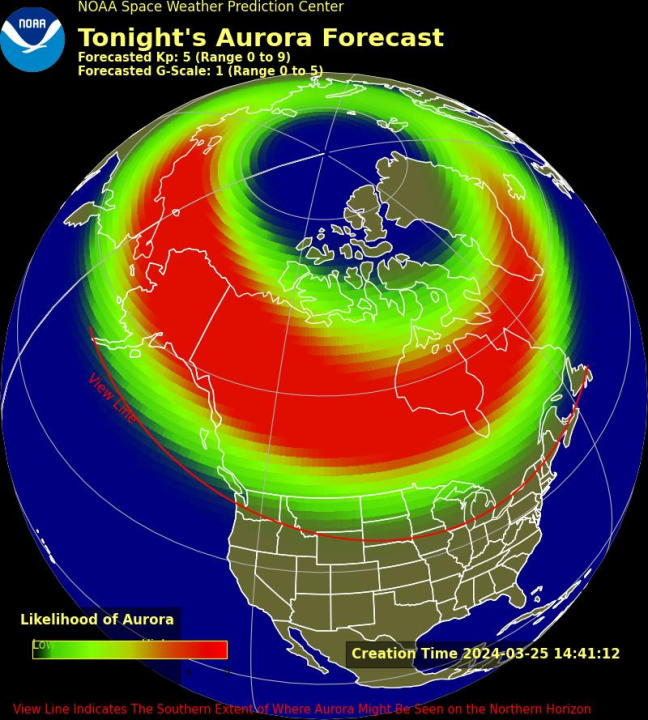After ‘severe’ geomagnetic storm, only some may see northern lights Monday: forecasts

(NEXSTAR) — The “severe” geomagnetic storming recorded over the weekend reached strengths known to send the northern lights as far south as Alabama, but it seems that may not be the case Monday night.
On Saturday, NOAA’s Space Weather Prediction Center issued geomagnetic storm watches through Monday as a coronal mass ejection and solar flare were on track to impact Earth. At the time, the agency said the geomagnetic storms could reach G2 “moderate” and G3 “strong” strength. The next day, the SWPC warned the storming had reached “severe” G4 conditions.
While that may sound serious, the SWPC notes there is no cause for alarm among the general public. There was, however, anticipation that the storming could bring the aurora to the U.S.
Northern lights could ramp up next year, and so could these strange occurrences
Coronal mass ejections, or CMEs, are explosions of plasma and magnetic material from the sun. If it shoots out into space in just the right direction, those CMEs can collide with our magnetic fields, sending particles to the North and South Poles, NASA explains. When those particles interact with oxygen and nitrogen, they can spark the northern lights.
That interaction is known as a geomagnetic storm, the strength of which will impact how far south the northern lights will be visible.
The SWPC uses a 5-point scale to measure the strength of geomagnetic storms, much like forecasters use scales for tornadoes and hurricanes. At the low end is G1, or minor storms that can make the northern lights visible in the northern portions of the U.S. (it’s worth noting that Alaska and much of Canada frequently have at least a slim chance of seeing the northern lights). G4 storming, which was recorded over the weekend, can send the northern lights as far south as northern California and into Alabama.
Unfortunately for the U.S., the geomagnetic storming was peaking during the daylight hours on Sunday, meaning we didn’t have a chance to see the aurora.
The moon is shrinking, study shows: How it could impact NASA missions
It also appears only a few in the Lower 48 will have the opportunity — albeit slim — to see the northern lights Monday night.
The SWPC’s Monday night aurora forecast is seen below. Areas blanketed in red have the highest likelihood of seeing the northern lights, while those in green have a lower likelihood. Alaska and much of Canada could get a glimpse of the dancing celestial lights.
As for the rest of North America, it seems only the northern portions of a few states have a slim chance at a glowing show Monday night: Washington, Idaho, Montana, North Dakota, Minnesota, and Michigan. Others, located north of the red view line, may just be able to see an auroral glow on the northern horizon: northern Wyoming, South Dakota, northern Iowa, Wisconsin, New York, Vermont, New Hampshire, and Maine.

The aurora forecast produced by the University of Alaska Fairbanks Geophysical Institute, however, shows slightly better odds at the northern lights shimmering in the Lower 48.
As of Monday morning, the Institute is forecasting high auroral activity, noting that “weather permitting, highly active auroral displays” will reach as far south as Oregon, Nebraska, Illinois, Indiana, Ohio, Pennsylvania, New Jersey, Connecticut, and Massachusetts. The view line is also forecasted to stretch into northern California and through Nevada, Utah, Colorado, Oklahoma, Arkansas, Tennessee, and North Carolina.
That auroral monitor uses data from NOAA; however, it’s often based on long-term predictions, The Associated Press previously reported.
The forecasts also don’t take into account cloud cover or local weather conditions. Minnesota and Wisconsin, for example, are expected to see rain (or snow) throughout Monday and into the nighttime hours, greatly limiting any chance they may have had at seeing the northern lights.
There’s a chance geomagnetic activity like this will pick up a bit in the coming months.
Is tap water safe to drink? CDC report highlights deadly waterborne infections
According to NOAA, we’re nearing the peak of Solar Cycle 25, an 11-year period in which the sun flips its north and south poles. During this time, various space weather events can occur that can bring geomagnetic storms — and the northern lights — to us on Earth.
While it can be difficult to tell when exactly the U.S. will have the chance to see the aurora borealis, NOAA does offer single-day and next-day forecasts for potential northern light viewing.
For the latest news, weather, sports, and streaming video, head to PIX11.

